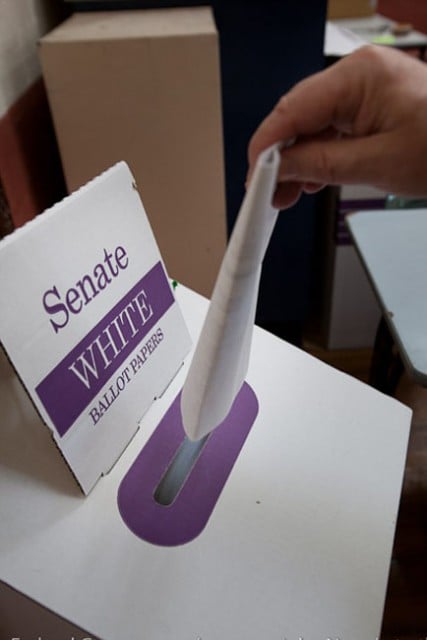How did it come to pass that many voters are going to need a magnifying glass to find who to vote for on September 7 from among the record number of 45 parties squeezed across the metre-wide NSW senate ballot paper?, asks Graham Askey.
The blame lies with a seemingly sensible change to the senate voting method thought up by clever ALP numbers men in 1984. At that time, all of the boxes for all of the candidates on the senate ballot paper had to be numbered correctly by each and every voter. ALP scrutinisers reported that Labor, apparently, was losing about 0.5 per cent of the vote because intending Labor voters were more likely to make a mistake in filling out their ballot. To mitigate this loss, the Hawke government introduced ‘above the line voting’, where just one box needed to be marked to cast a formal vote.
The rest of the preference numbers were, in effect, filled in by the party when they lodged their ‘group voting ticket’. The Electoral Commission were in agreement with the reform because it greatly speeded up the count and reduced informality.
At the same time the government increased the number of senators to be elected in each state from five to six which crucially reduced the ‘quota’ required to be elected from 16.7 per cent to 14.3 per cent. In a proportional preferential election, with voters filling in their own choice of preferences, a candidate usually needs to start with a primary vote of at least half a quota to be in the hunt to be elected. Back then, the only minor party consistently getting that sort of vote were the Democrats. The new system suited them just as well and kept them in the balance of power for the next 20 years.
Lurking in the implications of the streamlined ‘above the line’ voting method, however, was the potential for upper house elections to be gamed by smart operators.
Micro-parties
Because preference flows were now directed, solely, by just one party official, the resources required to print ‘How to Vote’ cards and marshal troops on the ground to ‘hand them out’ were no longer necessary to back up any promises about passing on preferences. This encouraged tiny parties, with little more going for them than an attractive name, to get on the ballot paper.
If there were enough of them they could then start swapping preferences between themselves in the hope that if all the small parcels vote were to eventually to collect with just one of them they might add up to a ‘quota’ and elect one of them. These micro-parties could also auction their preferences to whichever major party offered the best policy on their particular political issue.
Small political parties swap or offer preferences to other parties for three reasons. Firstly, to actually harvest enough votes to get elected. Failing that, then to assist in the election of another party with similar policies. Thirdly, to bring about some real policy changes by offering preferences to, or threatening withdrawal of preferences from, a major party.
As small political groups woke up to these possibilities more and more, parties were registered and started appearing on the senate ballot papers. In 2001 Kerry Nettle was elected in NSW with barely four per cent of the primary vote and Steve Fielding in 2004 and John Madigan in 2010 managed it in Victoria with less than two per cent. Now everyone wants to get in on the act.
From a simple choice in 1983 between Labor, the Coalition, the Democrats, and perhaps two or three others, the electorate can now spray their votes anywhere among 45 groups in NSW. Apart from three or four concocted ‘front’ parties, they are all legitimate political parties who are using this election to promote their causes. But at least two thirds of them also see the election for the final sixth spot as a lucky dip; they want to be in the draw to win.
This is because with so much choice on offer it is likely that there will be a ‘quota’ or more in the ‘others’ column. The ‘owner’ of those ‘front’ parties by the way has spent at least $120,000 on nomination fees alone.
Loose alliance
About 30 of the small parties, right across the political spectrum, have entered into a loose alliance where they agreed to preference each other before any of the three major parties. Quite a few of them have held their noses, been totally cynical, and have preferenced every other party in the alliance regardless of their politics in a real attempt to win the lottery. Most however couldn’t go quite so far and have reduced their chances by not swapping with those antithetical to their particular cause.
The best way for any voter to make a judgment on how any party’s preferences, and this includes the majors because some of their votes may well be distributed, is to visit Antony Green’s Election Guide online (www.abc.net.au/news/federal-election-2013/guide), where all of the parties’ preference lists have been published. This is what I have done and by analysing the preference swaps and with a fair bit of guesswork I venture the following predictions.
My predictions
With the Coalition polling well, and the fact that Labor has directly preferenced the Greens in NSW, the outcome will most probably be the same as in 2010 – three Coalition, two Labor and one Green. The cross-preferencing game will have come to naught.
There is, however, a small chance that late in the count the Coalition’s third candidate and the Greens may stall at just short of a quota. In this intriguing case I predict that the Liberal Democrats (LDP), the Shooters and Fishers (SFP), along with the almost-elected Greens and Liberal will be vying for the final two spots. Just which two win depends on who loses first. So in order of probability:
• It is most likely that the LDP will be first excluded and their bag of preferences will elect the Green and the Liberal.
• If it is the SFP who goes first, then their holding of preferences will certainly elect the Libs, and probably elect the LDP unless the Greens is very close to a quota.
• In the unlikely case that it is the Greens bowing out first then their own preferences certainly elect the Lib and the LDP.
• Most unlikely is that the Lib will drop first and elect (because the Greens are second last on their ticket) the SFP and the LDP.
Change needed
Since with any listing of preferences the only party which is guaranteed not to receive another party’s preferences is the one who is placed last, it is impossible to avoid unintended consequences very late in the count. It won’t be the first time if a Greens is elected on the back of a swag of One Nation preferences.
My view is that this election has finally proved that the ‘above the line’ way of marking a ballot needs to be replaced with a method that gives control back to the voter. If it isn’t, expect 100 parties next time.
There is a simple, if tedious, way to avoid all of these Byzantine backroom deals: vote ‘below the line’ and be your own numbers person. Best of all, you get to choose who goes dead last.
Graham Askey is the secretary of the HEMP Party
See more election coverage on our Election 2013 page




